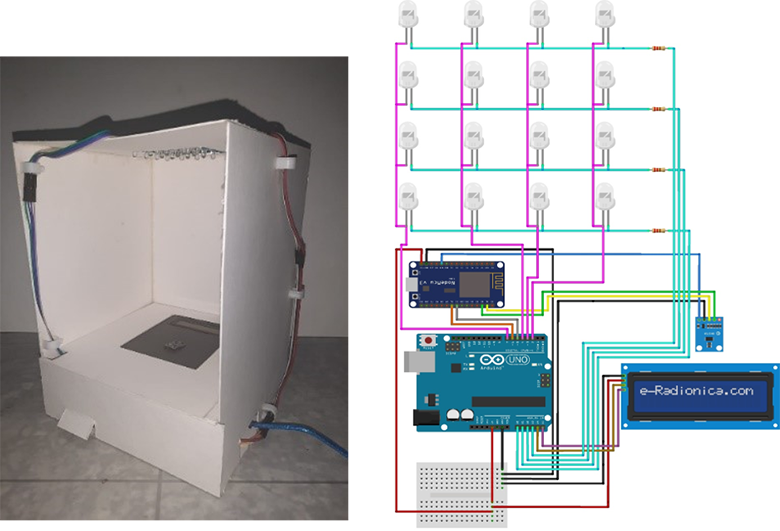Design of Light Intensity Control Device based on LED Matrix Control Wireless Lamp
DOI:
https://doi.org/10.12928/biste.v3i2.3697Keywords:
Intensitas Cahaya, BH1750, Arduino, Nirkabel, PWM, LED MatriksAbstract
This research make a wireless lamp light intensity regulator device based on LED matrix control. The device regulates lamp light intensity that is conform with the eating, sleeping, reading, using a laptop activities based on the existing provisions in SNI 03-6575-2001. The Arduino Uno ATMega328 microcontroller used to control the number of LED lamps that are light up to adjust the intensity of the light that fall upon the surface (lux) according to the activity that selected by user's smartphone. The BH1750 sensor will detect the light intensity produced by the lamp as information of the lamp light intensity condition. This research has been completed and succeeded in making a wireless lamp light intensity regulator device based on LED Matrix Control which can adjust the lamp light intensity of the lamp conform with the activities that the user want to do according to SNI 03-6575-2001. The device has been successfully created with an error percentage of 1.33% on examination with four different types of activities with total of 20 trials.
Penelitian ini membuat alat pengatur intensitas cahaya lampu nirkabel berbasis kendali matriks LED. Alat mengatur intensitas cahaya lampu dengan menyesuaikan pada kegiatan makan, tidur, membaca, menggunakan laptop berdasarkan ketentuan yang ada pada SNI 03-6575-2001. Mikrokontroler ATMega328 Arduino Uno digunakan untuk mengendalikan jumlah lampu LED yang menyala guna mengatur intensitas cahaya yang akan jatuh ke permukaan (lux) menyesuaikan dengan kegiatan yang dipilih melalui smartphone pengguna. Sensor BH1750 akan mendeteksi intensitas cahaya yang dihasilkan oleh lampu sebagai informasi kondisi intensitas cahaya lampu. Penelitian ini sudah selesai dilakukan dan berhasil membuat Alat Pengatur Intensitas Cahaya Lampu Nirkabel berbasis Kendali Matriks LED yang dapat mengatur intensitas cahaya lampu berdasarkan kegiatan yang akan dilakukan pengguna menyesuaikan SNI 03-6575-2001. Alat telah berhasil dibuat dengan persentase error 1,33% pada pengujian terhadap empat jenis kegiatan yang berbeda dengan total 20 kali percobaan.References
Badan Standar Nasional Indonesia, “SNI 03-6575-2001 tentang Tata Cara Perancangan Sistem Pencahayaan Buatan pada Bangunan Gedung,” pp. 1–32, 2001.
Wanto, “Rancang Bangun Pengukur Intensitas Cahaya Tampak berbasis Mikrokontroler,” Tugas Akhir, pp. 1–49, 2008.
M. Rianti, “Rancang Bangun Alat Ukur Intensitas Cahaya dengan menggunakan Sensor Bh1750 Berbasis Arduino,” Tugas Akhir, 2017. http://repositori.usu.ac.id/handle/123456789/3805
A. Yufron, “Mikrokontroler AT Mega 8535 sebagai Pengendali Intensitas Lampu Pijar,” J. Qua Tek., vol. 6, no. 1, pp. 69–87, 2016. https://doi.org/10.30957/quateknika.v6i1.338
Robyansah, “Alat Pengatur Intensitas Cahaya Lampu Penerangan Otomatis pada Ruangan dengan Metode Proporsional berbasis Mikrokontroler ATMega32,” Tugas Akhir, 2015.
M. Pamungkas, Hafiddudin, and Y. S. Rohmah, “Perancangan dan Realisasi Alat Pengukur Intensitas Cahaya,” J. Elkomika, vol. 3, no. 2, pp. 120–132, 2017. https://doi.org/10.26760/elkomika.v3i2.120
G. Turesna, Zulkarnain, and Hermawan, “Pengendali Intensitas Lampu Ruangan Berbasis Arduino UNO Menggunakan Metode Fuzzy Logic,” J. Otomasi Kontrol dan Instrumentasi, vol. 7, no. 2, pp. 73–88, 2017. https://doi.org/10.5614/joki.2015.7.2.2
Y. S. Hariyani, C. Fitri, and S. Hadiyoso, “Realisasi Pengendali Intensitas Cahaya Lampu dengan Kontrol Suara dan Google Android Speech Recognition API,” J. Elektro Telekomun. Terap., pp. 67–74, 2014. https://doi.org/10.25124/jett.v1i1.86
S. Rumalutur, “Analisis Keamanan Jaringan Wireless LAN (WLAN) Pada PT. PLN (Persero) Wilayah P2B Area Sorong,” J. Teknol. dan Rekayasa, vol. 1, no. 1, pp. 62–74, 2015. https://doi.org/10.32531/jelekn.v1i1.15
W. A. Arbaugh, N. Shankar, Y. C. J. Wan, and K. Zhang, “Wireless Network has No Clothes,” IEEE Wirel. Commun., 2002. https://doi.org/10.1142/9789812799562_0013
W. Hakim and T. Turmudi, “Sistem Pendukung Keputusan Metode Sugeno dalam Menentukan Tingkat Kepribadian Siswa Berdasarkan Pendidikan,” CAUCHY, vol. 4, no. 1, pp. 48–56, Nov. 2015. https://doi.org/10.18860/ca.v4i1.3174

Downloads
Published
How to Cite
Issue
Section
License
Copyright (c) 2021 Geri Renalda Ambotang, Nuyono Satya Widodo

This work is licensed under a Creative Commons Attribution-ShareAlike 4.0 International License.
Authors who publish with this journal agree to the following terms:
- Authors retain copyright and grant the journal right of first publication with the work simultaneously licensed under a Creative Commons Attribution License that allows others to share the work with an acknowledgment of the work's authorship and initial publication in this journal.
- Authors are able to enter into separate, additional contractual arrangements for the non-exclusive distribution of the journal's published version of the work (e.g., post it to an institutional repository or publish it in a book), with an acknowledgment of its initial publication in this journal.
- Authors are permitted and encouraged to post their work online (e.g., in institutional repositories or on their website) prior to and during the submission process, as it can lead to productive exchanges, as well as earlier and greater citation of published work (See The Effect of Open Access).
This journal is licensed under a Creative Commons Attribution-ShareAlike 4.0 International License.


